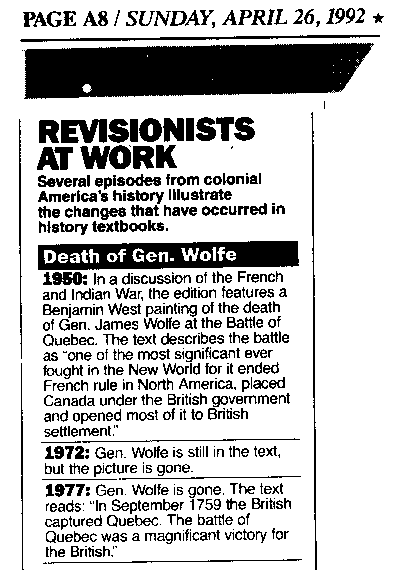1) Divine, America Past and Present, 2nd. ed., includes West's painting in color with the caption "The British soundly defeated the French at Quebec in 1759, but their brilliant commander, General James Wolfe, fell mortally wounded." The abbreviated version of the same text has a black and white excerpt of the painting with the caption "The British soundly defeated the French at Quebec in 1759 with superior stragegy and force of arms in a battle that proved to be the climax of the French and Indian War. However, it cost the British the life of their brilliant commander, General James Wolfe." (See p. 115 & p. 66). For a different view of the brilliance of Wolfe's strategy click here.
2) Norton, A People & A Nation, 3rd. ed., contains an account of the battle with a contemporary? color graphic from the Library of Congress of the assault on the cliff. It also notes the deaths of Montcalm and Wolfe, explains that the victory (September 13, 1759) brought the Iroquois (until then neutral) over to the side of the English, and includes a good map of the colonies in 1750. (see pp. 108-109)
3) Blum, The National Experience, 7th ed., contains an account of the battle (which it implies was fought on September 12, 1759) and the deaths of the generals, but not West's painting. A graphic of Wolfe is labled "a martinet with talent" and there is a good map of the military campaigns in the region.
4) Henretta, America's History, 2nd. ed., does not date the battle but describes the attack without mentioning Wolfe's death. A graphic of Wolfe is included on p. 137, which labels him "The British Hero," which was taken from a print intended to warn "the King against "Evil and Corrupt Ministers.""
5) Tindall, America A Narrative History, 1st. ed., discusses the importance of the year 1759 in the history of the British Empire, the annus mirabilis or miracle year, in which the British took French Canada and India. The text accurately describes the chronology of the battle (September 12-13, 1759) and includes the same contemporary graphic of the battle as Norton but attributes it to the National Army Museum, London.

Click here for color graphics of who is 'in' and who is 'out' according to the ©Washington Times, 1992